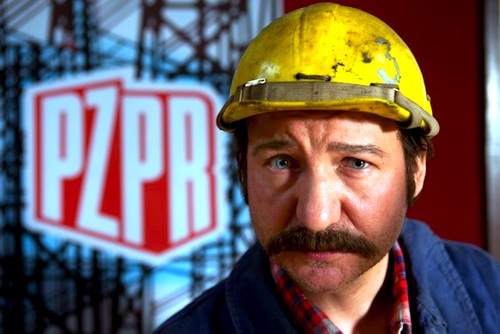By Joe Bendel. He is an electrician with a Nobel Peace Prize and a Presidential Medal of Freedom. That would be none other than Lech Wałęsa, the co-founder and leader of Poland’s first independent trade union, Solidarity. Notoriously blunt-spoken and inconveniently principled, Wałęsa has become a figure of controversy in post-Cold War Europe—so much so honorary Academy Award winner Andrzej Wajda felt compelled to set the record straight on film. Representing Poland as its official foreign language Academy Award submission, Wajda’s Walesa, Man of Hope, merits serious award consideration wherever it is eligible.
Robert Więckiewicz is a strong likeness for Walesa, as Wajda would know, since the Solidarity leader appeared as himself in the director’s 1981 Palme D’Or winning Man of Iron. Revisiting the era of his classic duology, Wajda even includes brief Easter egg snippets of Man of Marble and its companion film. However, Wajda’s fictional characters are merely cinematic window-dressing, yielding to the historical record.
Brash yet reflective, Walesa was one of the few people capable of impressing celebrated Italian iconoclast-journalist Oriana Fallaci, whose interview with the still relatively young Solidarity leader serves as the film’s framing device. Even at this early stage of his career, Walesa has accepted his role as a man of destiny. Yet, as he explains to Fallaci (played with suitably charismatic flair by Maria Rosario Omaggio), it was not always so. Resolutely opposed to violence on both moral and pragmatic grounds, Walesa initially advocated more modest demands. However, he instinctively recognizes that the national zeitgeist has reached a turning point.

Wajda’s Walesa is not hagiography, except perhaps with regards to Walesa’s long suffering wife Danuta. Więckiewicz’s portrayal certainly suggests the Solidarity leader did not lack for confidence, but there is a roguish charm to his bluster (as well as the obvious historical justification). He also constantly tries his beloved Danuta’s patience, but the love shines through in all of Więckiewicz’s scenes with Agnieszka Grochowska. Still, Wajda clearly has special sympathy for Ms. Walesa, saving his greatest outrage for the abusive treatment she receives from the authorities when returning from Oslo with her husband’s Nobel Prize.
For a searing indictment of the Communist era, Wajda’s Katyn is tough to beat. While his Walesa obviously shares some common themes, it is a different sort of film. More personal in scope, it celebrates the Walesas, his comrades in Solidarity, and his unique foibles. While Katyn’s sense of outrage is impassioned and visceral, Man of Hope is celebratory and even nostalgic for the idealism and solidarity (if you will) of Solidarity’s headiest days.
Frankly, it is rather baffling that Walesa: Man of Hope has not had more Oscar buzz. How many films feature two defining figures of their eras (Walesa and Fallaci) on-screen, with a third titan (Wajda) behind the camera? It is a quality period production, with Magdalena Dipont’s design team perfectly recreating the look and dank, depressed vibe of Brezhnev-era Gdansk. Refreshingly earnest and enthusiastic, Wajda’s Walesa gives thanks for Poland’s new era of freedom and pays tribute to those who fought to realize it. It is the sort of film all American civics students should see. Highly recommended (especially to the Academy) Walesa, Man of Hope should have a considerable life on the festival circuit and eventual distribution, regardless of what Oscar decides.
LFM GRADE: A
Posted on December 18th, 2013 at 11:43am.